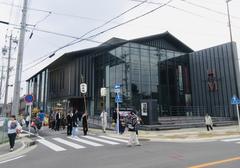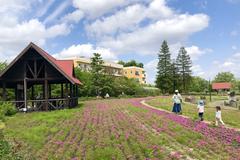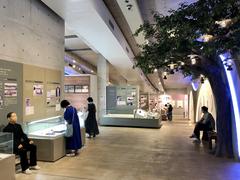Port of Kinuura: Visiting Hours, Tickets, and Visitor Guide in Handa, Japan
Date: 15/06/2025
Introduction
Located on the northeastern edge of the Chita Peninsula in Handa City, Aichi Prefecture, the Port of Kinuura stands as a testament to Japan’s industrial prowess and maritime heritage. As a central node in the Chukyo Industrial Belt, the port has played a vital role in the nation’s economic development—facilitating trade, supporting heavy industries, and fostering cultural exchange. Its evolution from the Meiji Restoration’s industrialization to its current focus on sustainability and digital logistics underscores its enduring significance (MLIT, 2024; E-Tracking).
Despite being primarily an industrial port, Kinuura is also accessible to visitors seeking to learn about Japan’s maritime evolution, environmental initiatives such as the adjacent Handa Biomass Power Plant, and local history. Guided tours, festivals, and nearby attractions like the Handa Red Brick Warehouse and Mizkan Museum make it a rewarding destination for both industrial tourism and cultural exploration (Handa City Tourism; MarineLink).
This guide presents everything you need to plan your visit, including historical context, visitor information, transportation options, attractions, accessibility, and practical tips for an enriching experience.
Table of Contents
- Historical Background of the Port of Kinuura
- Visiting Hours and Ticket Information
- How to Get There: Transportation and Accessibility
- Tours and Special Events
- Nearby Attractions in Handa City
- Environmental Initiatives and Renewable Energy
- Visitor Experience: Practical Tips
- Frequently Asked Questions (FAQ)
- Summary and Recommendations
- References and Further Reading
1. Historical Background of the Port of Kinuura
The Port of Kinuura’s roots trace back to Japan’s rapid industrialization, capitalizing on its strategic position along Pacific trade routes (JAPAN Forward). Once a commercial hub during the Meiji era, the port expanded post-World War II, supporting heavy industries such as steel, chemicals, and machinery. Its integration into the Port of Nagoya system further cemented its role in global logistics (E-Tracking).
Modernization efforts in the latter half of the 20th century introduced containerization and digital logistics, while recent decades have emphasized environmental sustainability and renewable energy.
2. Visiting Hours and Ticket Information
- General Access: The Port of Kinuura is an operational industrial facility, with most areas restricted to authorized personnel.
- Observation Areas & Visitor Centers: Select areas, such as observation decks and adjacent museums, are generally open from 9:00 AM to 5:00 PM.
- Guided Tours: Arranged in advance through the Handa City Tourism Office or port authority; some tours may have fees.
- Special Events: Festivals and educational workshops are scheduled seasonally—check official websites for up-to-date details.
There is no general admission or ticket required for public observation areas; however, guided tours and event participation may require advance booking.
3. How to Get There: Transportation and Accessibility
By Train:
- Take the JR Taketoyo Line to Handa Station; the port is approximately 3 km away, accessible via local buses or taxis.
By Car:
- The port connects directly to regional highways, with parking available for visitors in designated areas.
By Air:
- Chubu Centrair International Airport is about 25 km from Handa, with bus and train links to the city.
Accessibility:
- Most public and cultural sites near Kinuura are wheelchair accessible. For specific needs, contact venues in advance.
4. Tours and Special Events
- Handa City organizes guided walking tours of historic warehouses, breweries, and waterfronts.
- Maritime festivals offer ship-spotting, performances, and workshops celebrating local culture and industry.
- School and educational groups can arrange in-depth port observation programs.
Check the Handa City Tourism and Kinuura Port Authority sites for schedules and booking procedures.
5. Nearby Attractions in Handa City
- Handa Red Brick Warehouse: Historic industrial building turned cultural venue.
- Mizkan Museum: Showcasing vinegar brewing history with tastings and interactive exhibits (Wanderlog).
- Handa Canal & Black-Walled Warehouses: Reflecting the city’s shipping and brewing legacy.
- Kunizakari Sake Cultural Hall: Tradition-rich sake brewery museum.
- Handa Dashi Float Festival: Annual event featuring traditional floats.
- Local Temples and Shrines: Including Sumiyoshi Shrine and Unkanji Temple.
These attractions offer a well-rounded perspective on Handa’s maritime, industrial, and cultural traditions.
6. Environmental Initiatives and Renewable Energy
Kinuura is a leader in port sustainability. The Handa Biomass Power Plant, Japan’s largest, is adjacent to the port, using wood chips and other renewable biomass for clean energy production (UABio; NS Energy Business). The port also enforces strict environmental monitoring and noise/dust control, supporting both industry and local community well-being.
7. Visitor Experience: Practical Tips
- Weather: June is humid and rainy, with average temperatures around 25°C. Dress comfortably and bring rain gear (Tourist Japan).
- Language: English signage is limited; a translation app can help.
- Payments: Carry cash or IC cards, as some small businesses may not accept foreign credit cards (Two Wandering Soles).
- Safety: Observe all posted rules in operational areas; guided tours provide necessary safety equipment if needed.
- Photography: Allowed in public areas, but restricted within the industrial port—always ask for permission.
8. Frequently Asked Questions (FAQ)
Q: What are the Port of Kinuura’s visiting hours?
A: Public observation areas are generally open 9:00 AM–5:00 PM. Guided tours require advance booking.
Q: Are tickets required?
A: General visits are free; tours or special events may require reservations.
Q: How do I access the port from Nagoya?
A: By train (JR Taketoyo Line) or car; roughly 30–40 minutes.
Q: Is the port accessible for people with disabilities?
A: Most public facilities are accessible, but confirm with individual venues for specific needs.
Q: Can I visit without a guide?
A: Observation areas are open, but operational zones require a guide and prior arrangement.
9. Summary and Recommendations
The Port of Kinuura blends industrial might with cultural depth, offering visitors a unique look at Japan’s economic engine and maritime traditions. With a range of historical sites, guided tours, and environmental initiatives, Kinuura is ideal for travelers interested in industry, sustainability, and local culture. Plan ahead—especially for tours and special events—and use local resources or the Audiala app for personalized guidance. Don’t miss the chance to explore Handa’s rich legacy and enjoy its distinctive port city charm.
10. References and Further Reading
- MLIT official port information, 2024
- Visiting the Port of Kinuura: History, Tours, and Travel Tips in Handa City, 2025
- Port of Kinuura: Visitor Information, Industrial Significance, and Key Details for Aichi Prefecture, 2025
- Visiting the Port of Kinuura in Handa: Hours, Tickets, and Nearby Attractions, 2025
- JAPAN Forward, Japan maritime history and sea trade route, 2024
- UABio, Biomass power plant news, 2017
- NS Energy Business, Biomass power plant construction, 2015
- MarineLink, Port of Kinuura information, 2025
- Wanderlog, Top attractions in Handa
- Tourist Japan, Japan in June
- Two Wandering Soles, Japan travel tips
- Cogoport, Kinuura port info



